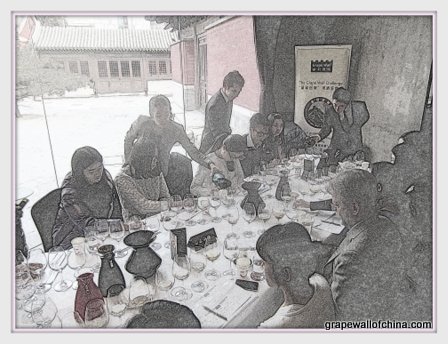
By Jim Boyce | And just like that, Grape Wall of China is ten years old. The site officially launched on this day in 2007 and has been a labor of usually love and sometimes loathing, one that absorbs much time and money, takes occasional breaks, and provides both fascinating and frustrating adventures.
There have been good times: meeting cool people, trying thousands of wines, traveling about China, and hopefully helping fellow consumers. And some bad ones: headache-inducing IT issues, people who aim snark at this site while professing a desire to make wine accessible, and the odd angry distributor or educator.
Grape Wall started as a sibling to nightlife site Beijing Boyce. One goal was to post English-language coverage of China’s wine scene, something no one was consistently doing. Another was to improve foreign media coverage of that scene by connecting reporters to a list of contributors:Â locally based wine-makers, sommeliers, producers and so on. Yet another was simply to find good local wines.
I plan to write a few “ten” posts in the next few months—ten best Chinese wines, ten biggest Grape Wall supporters, and more. But for now, I’ll post ten photos and captions that capture what Grape Wall has at least meant to me—expect this to be a lot more introspective than the typical post—during the past decade.
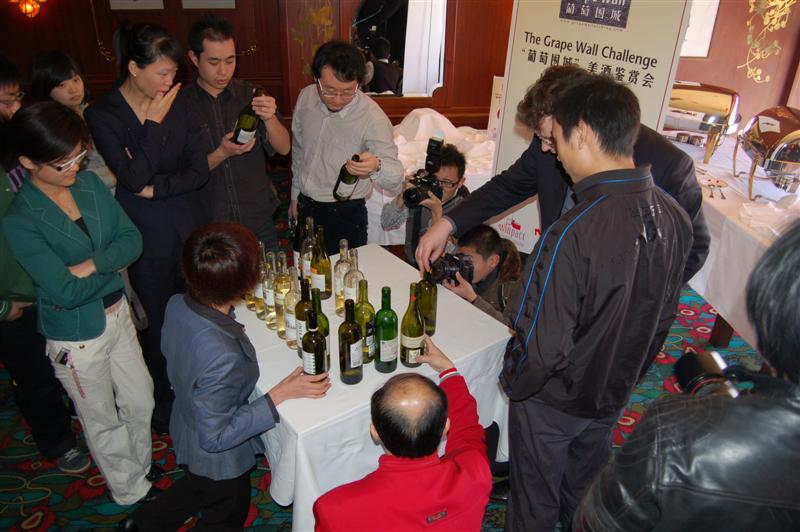
Our annual signature event, Grape Wall Challenge, asks Chinese consumers to be wine judges. They show up, blind-taste a dozen-plus wines, rank each as “love it”, “like it”, “dislike it” or “hate it”, then discuss their picks with professor Ma Huiqin. The support from the distributors who provided wine, the venues who provided space and the consumers who served as judges has been inspiring. (See yearly results here.)
A few things we’ve discovered: consumers like white wine more than many in the trade believe. They typically like wine from Argentina and South Africa. And even the most nervous newcomer leaves with more confidence about discussing wine, which really is the purpose of these tastings.
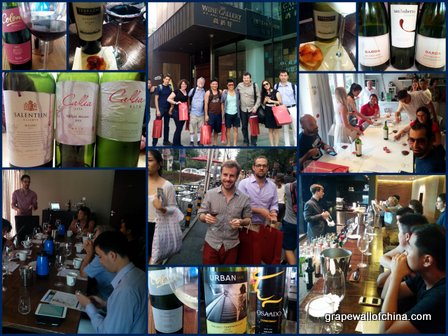
It’s one thing to write about wines and another to get them into consumer mouths. After a superb trip to Argentina in 2014—Salta!—I decided to focus energy not on follow-up posts but an ‘ArgenChina‘ tour. Participants visited five bars / restaurants in Beijing, with each featuring a white and a red from a different region of Argentina. Add snacks like alfajores, a tango lesson and support from Wines of Argentina, and it was an entertaining day. This was just one of many tastings organized by Grape Wall.
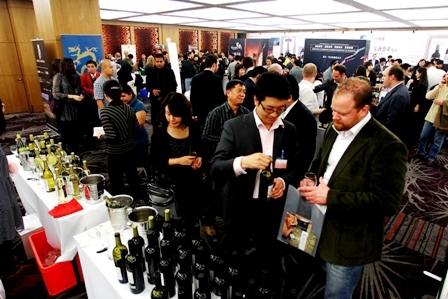
For a good decade, the annual Hilton Beijing wine fair was my favorite event. With thousands of wines, including many local ones, it promised a most excellent day of tasting. And for a few years, an enthusiastic team led by former F&B director Simon Amos provided prizes, including hundreds of tickets and a presidential suite stay, for me to give away in contests. Those contests asked Grape Wall readers to do everything from invent a ‘celebrity’ wine (Syrah Elton John, Lady GaGamay and Chianti Reeves all featured) to explain who they would most like to share a bottle with. Good times!

Grape Wall has also been a platform for charity work, most notably for Maovember, an annual campaign I help organize. The photo shows a China vs France wine tasting at Cafe de La Poste, one of the events that over the years has helped Orbis provide cataract surgery to the elderly in rural areas and Library Project provide books to schools in need. See here for the wine-related events from last year’s campaign.
Grape Wall has allowed me to meet some of the world’s most interesting wine people. Without this site, without essentially being in the right place at the right time, I doubt I would have attended the Robert Parker trade tasting or the dinner he hosted on the Great Wall. Or sat on a panel with Stephen Spurrier at a Hong Kong wine fair. Or learned about Tim Hanni and, when he visited Beijing, set up a media tasting. Or, during the Beijing Olympics, picked up the phone to find Jean-Michel Cazes on the other line: he found Grape Wall via Google.
And there are many more. Like Jancis Robinson (above): I saw a wine column she wrote in Financial Times, emailed the generic ft.com address below it to tell her about Grape Wall, got a response from her almost immediately and soon met her in Beijing. (She wasn’t impressed with the two Chinese wines I brought.) While my main focus is local wines and people, it’s helpful to meet and learn from these global experts.
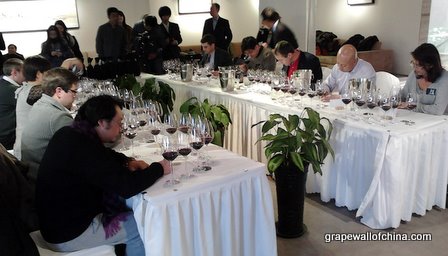
Grape Wall organized the Ningxia-Bordeaux Challenge in 2011 with distributor TasteV, an event that led to much media coverage. Many pigeonholed the contest as a Judgment of Paris deal but the purpose was more consumer-oriented: if someone in China had rmb300 to rmb500 and a choice of our ten wines (five from Ningxia, five from Bordeaux) in that price range, what ones would our judges (five from China, five from France) recommend?
I remember counting the scores—a Wall Street Journal reporter double-checked them—and the bottles then being revealed one by one, starting with fifth place. It was from Bordeaux. I got nervous and prayed at least one Ningxia wine would make the top five lest I be banished from the region. Ningxia swept the next four places and, with AFP, Reuters and other major media in attendance, the story soon spread around the world.
And my email box and the blog’s comment section soon filled, with some trade people—seemingly missing the consumer angle—expressing outrage. For me, the key messages were simple: local producers could make pretty good wine, albeit in small quantities, and Chinese consumers were paying way too much for that Bordeaux.

The Ningxia-Bordeaux Challenge led to my involvement in Ningxia Winemakers Challenge. The new wine bureau in Ningxia asked me to help bring ten foreign wine-makers to the region in 2012 as part of a two-year contest with USD30,000 in prizes. This would mean balancing Grape Wall with an outside project, but one that was irresistibly interesting.
The funny thing is that I’d been planning to leave China, had gone to Ningxia for perhaps a last visit, ended up doing too many group toasts at a dinner and then, dizzy in the car back to the hotel, learned that my fellow diners included some officials who wanted me to bring wine-makers to Ningxia. In less than ten weeks. That’s just how it works in China sometimes.
Anyway, I flew back to Beijing, built a website in two days, gathered applications for 17 days, had an international panel pick the top candidates in a week, then handed the baton to the Ningxia team to get plane tickets, lodgings and a massive amount of logistics done. Just over a month later, seven winemakers from seven countries arrived in Ningxia.
Symbolic of the region’s growth and ambitions, the second Ningxia Winemakers Challenge, launched in 2015, called for 60 candidates. Of those selected, 48 winemakers from 18 countries eventually made it to the region and will see their wines judged in the next two months, with prize money this time totaling USD110,000.
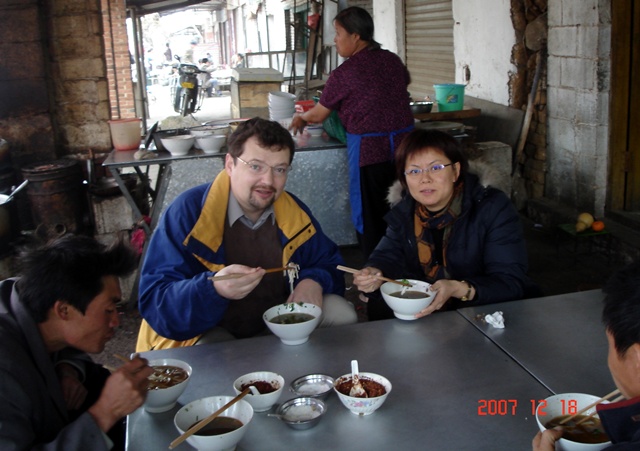
I’ve been lucky to visit wineries around China, including in Gansu, Hebei, Ningxia Shandong, Shanxi and Xinjiang. These have ranged the sprawling operations of Changyu and Great Wall to mom and pop outfits, and everything in between. This photo is from the first trip after Grape Wall’s founding, to Yunnan in 2007, with Professor Ma Huiqin. This breakfast was good fuel for a morning of visiting vineyards. One trip highlight was meeting Yunnan Hong CEO Wu Kegang, whose house has the biggest fireplace I have ever seen
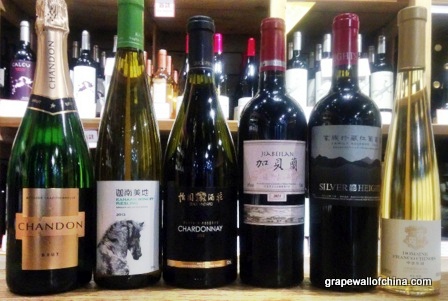
Exploring Chinese wine is a major, and the most fun, part of Grape Wall. During the past decade, we’ve gone from asking “Are there any good wines in China?” to “Which ones are the best?” Now the goal is to find value-for-money and interesting wines.
Grape Wall has organized over 100 tastings of Chinese wines, whether with visiting trade people, events like this, this or this, the Grape Wall Challenge, or fellow consumers. It’s always fun to gather some of the better Chinese wines—like the ones pictured above—and try them with newcomers.

Finally, in a nation where Cabernet rules vineyards, where shelves are overloaded with red wines despite evidence Chinese consumers, given the chance, also enjoy white ones, and where taste has only recently started to challenge status as a reason for buying wine, it’s good to see grapes like the Aglianico above making appearances. This is still such a new scene, with so many discoveries ahead. I think of trying Dragon Seal Huailai Reserve from the turn of the millennium, the first vintage of Silver Heights in 2007, the bubblies from Chandon and Grace Vineyard, the Marsellan popping up across the country and seemingly destined to become China’s grape, or that Aglianico, and they keep me excited about what’s coming next.
So, that’s one person’s look at a decade of Grape Wall. And there have been many other people involved in this site, whether as writers, academics, wine-makers, distributors, sommeliers, viticultarlists or crucial sources of advice. I’ll be posting more about those people, about the ten best wines of the decade, and more very soon.
That’s it for now. I’ll have posts on the key people behind Grape Wall, and there are  the best wines of the decade, and more.
Follow Grape Wall on Facebook and Twitter. Support this site here. And sign up for the newsletter below. You can also check sibling sites World Baijiu Day and Beijing Boyce.
Sign up for the Grape Wall newsletter here. Follow Grape Wall on LinkedIn, Instagram, Facebook and Twitter. And see my sibling sites World Marselan Day, World Baijiu Day and Beijing Boyce. Grape Wall has no advertisers, so if you find the content useful, please help cover the costs via PayPal, WeChat or Alipay. Contact Grape Wall via grapewallofchina (at) gmail.com.
Leave a Reply
You must be logged in to post a comment.